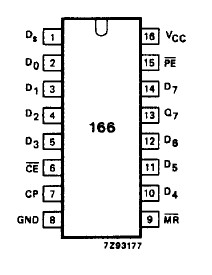74HCT166: Features: ` Synchronous parallel-to-serial applications` Synchronous serial data input for easy expansion` Clock enable for do nothing mode` Asynchronous master reset` For asynchronous parallel da...
floor Price/Ceiling Price
- Part Number:
- 74HCT166
- Supply Ability:
- 5000
Price Break
- Qty
- 1~5000
- Unit Price
- Negotiable
- Processing time
- 15 Days
SeekIC Buyer Protection PLUS - newly updated for 2013!
- Escrow Protection.
- Guaranteed refunds.
- Secure payments.
- Learn more >>
Month Sales
268 Transactions
Payment Methods
All payment methods are secure and covered by SeekIC Buyer Protection PLUS.

 74HCT166 Data Sheet
74HCT166 Data Sheet







